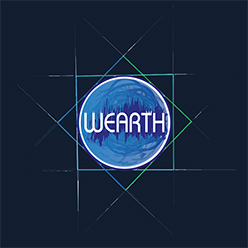Newsletter 3 - WEARTH in Italia: le prime parti rosse e verdi
(Italy, the first red and the green parts)
Dear Wearthies.
It’s been a while since you’ve heard from me on this channel of the Wearth Newsletter…
In the meantime, it’s wintry here, it’s cold and the pavements are slippery with ice, like walking on eggs. Light is in short supply. And if it weren’t for the end-of-year celebrations of various kinds, the mood would be rather downbeat. A good opportunity to take you to the centre of the Mediterranean, where the seasonal orange harvest is taking place, and there is no shortage of almonds and pistachios either: Sicily. In the first encounters with a region for our placements, I usually choose an approach based on the colours that play a role nationally. In later placements, when you know the country better, more subtle colour decisions can then characterise the dialogue with the local soil and biosphere. In the case of Sicily, these are variations of the colour red. This colour family, in its heterogeneity and simplicity, is a counterpoint to the more green tones of the north of Italy: magma, lava, the earth’s interior, love, power, blood are all justified associations, each of which suits Sicily well in its own way.
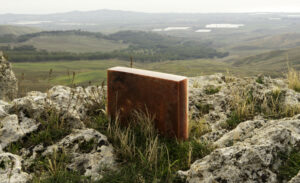
This image shows the Wearth encaustic brick “ROS”, 2E1A, in Butera, Sicilia. The white of the background is the mirroring sunlight onto the Mediterranean Sea; the white just below the horizon are huge plastic made greenhouses. Most of the rocks show either their volcanic origin or their former sea ground existence.
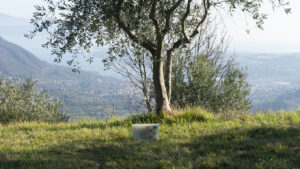
The placement of WEARTH encaustic brick 2A1A, *MADONNA*, overviewing Lake Garda, just below Santa Maria della Neve, Villanueva sul Clisi, took place under an olive tree on New Year’s day 2020. Luisa placed it there and shared her values with us. After this placement, Corona hit hard, especially this very Lombardy region.
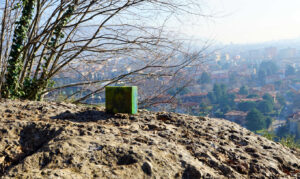
2A1B, BRESCIA, overviewing the city of Brescia, is placed in a nature park in Badia, Lombardy. Giovanna and her dog were telling their stories at this place.
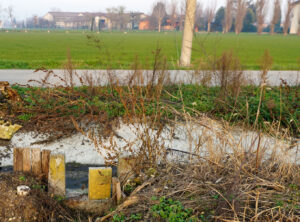
Whereas our first triangle placements (each arm has a length of 48 kilometres) are all in the northern Italian region called Lombardy, this area is rather heterogeneous: In its northern part it is mountainous, in the South, where 2A1C, „Ghedi“, is placed, it is very flat due to the influence of the Po and its tributaries, and the predominantly agricultural landscape is dotted with medium-sized industrial companies and US military bases.
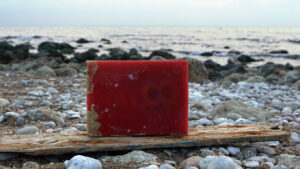
2E1B,“OTTO”, brought us on New Year’s day this year to the beach of Montechiaro, Sicilia. Lucia was the sculptor of this brick.
Both the rainbow colour of this „OTTO“ stone, which is vermilion red on the front, and the horizontal „eight“ (otto in Italian) point to infinity. On the other hand, anyone who speaks German, Italian or French is bound to think of our Emperor Otto the Great: Otto I (23 November 912 – 7 May 973), traditionally known as Otto the Great (German: Otto der Große Italian: Ottone il Grande), or Otto of Saxony (German: Otto von Sachsen Italian: Ottone di Sassonia) was East Frankish king from 936 and Holy Roman Emperor from 962 until his death in 973. He was the eldest son of Henry the Fowler and Matilda of Ringelheim.
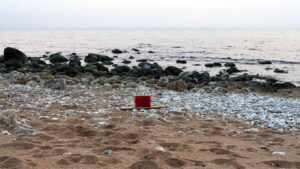
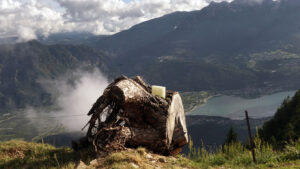
2B1B, the WEARTH brick called „BUSA“ placed in Busa Grande, Levico Terme, Trento, Italy
It took us Wearthies a while to master the climb from where we parked our car to where we placed this wax stone. The light was constantly changing: sometimes we were literally in the clouds, sometimes the sun was beating down directly on us. But one thing remained constant: a pair of eagles soared over us, our placement, and the neighbouring valleys. The place was an important defence post in the resistance against the German invaders.
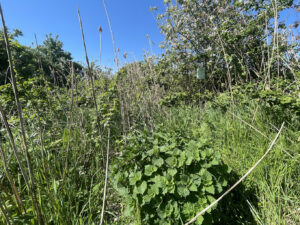
2C1A, „MANDRIOLE”, was placed in Ravenna Sant’ Alberto. More precisely, to the south, squeezed between the Romea road and the right bank of the Reno canal, lies the spectacular Valle Mandriole (or Valle della Canna) nature reserve, an unpopulated area that is home to numerous bird species, including the flamingos that love the Po Delta.
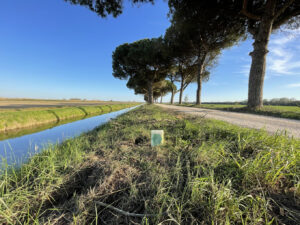
2C1B, “GORO”, was placed in Goro, Ferrara on a strip of meadow between an avenue of ancient pine trees and an agricultural irrigation and drainage canal.
The trees bear witness to how long agriculture has been practised here; the Po Valley is fertile.
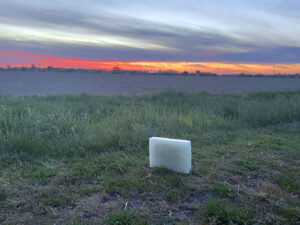
2C1C, “RO”, was placed in Ro, Riva del Po, Ferrara alongside another field, at the end of that day.
Of course, you will find green tones in the south and red in the north, but water is more abundant in the north and lava in the south.
It found its place in this moment between day and night, as if the moonlight had been captured cubically and speaks of a hexagon: longing for the perfect circular shape.
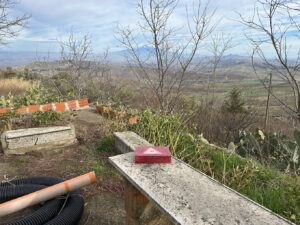
2D1A. “VENTO”, was placed on one of the territories of our local partner Filippo, straight forward looking to Mount Etna.
The name speaks for itself: in addition to Filippo and us Wearthies, a third co-creator came into play: the wind. It was so strong that there was no question of using the camera drone, and even so strong that it blew the stone over and placed it in its final position. This took place in such a way that the triangle on side 1 of the Wearth wax bar pointed directly towards the mountain/volcano Etna.
In addition to Filippo’s statements in the interview protocol, he told a number of stories in Sicily that helped us to better understand the existence of the local people. As a biologist, he initially worked as a pharmaceutical sales representative. A job that took him to every corner of Sicily; it’s hard to imagine meeting someone who knows his homeland better. Now he devotes himself full-time to his organically farmed agricultural land. He has also set up an „agriturismo“ on the developed land, which I would highly recommend to anyone planning to explore Sicily (Agriturismo Paparanza). I would like to share one of his stories with you here because it also concerns us: a local farmer produces tomatoes. He wants to sell them for 40 cents a kilo; certainly not too much to ask when you consider that the same kilo costs around 4 euros here in the supermarket. However, the big buyers don’t want to pay that, so he offers them for 20 cents, barely making a profit: With their almost limitless market power, they then push the farmers down to 5 cents per kilo. And, with the ongoing agricultural protests in this country, the Dutch farmers should be commended for not dumping their manure in front of government buildings during their protests, but in front of the branches of the big discounters. An agronomist friend of mine once explained to me very clearly that the problems in our food production and supply began when the farmers allowed the market to be taken out of their hands.
In view of these conditions, Filippo now only sells his products directly to his guests and contacts.
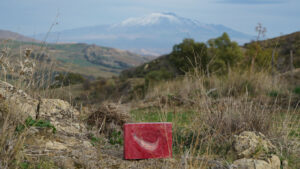
2D1B, “NIKE” was placed at a height 520 metres in Agira, Sicily, looking towards Mount Etna.
Yes, there’s that thing with the Greek goddess of victory, Nike, which is best seen in the Louvre in Paris. Her wings inspired a fairly well-known American sporting goods company to come up with the name and logo. The logo is intended to emulate the sweep of the wing. However, the US company could not bring itself to have its name pronounced as it was originally intended. Now everyone who wears wax wings knows what happens when you fly too close to the sun (or the volcano) …. The wing sweep in our wax stone is part of the jaw of a deceased mammal I found in a field. A sheep?
Etna in the background was not spewing red lava, just the occasional indeterminate plume of smoke, tracing its message in the Sicilian sky.
Our southern red may remind us that this volcano can do it any time it wants to.
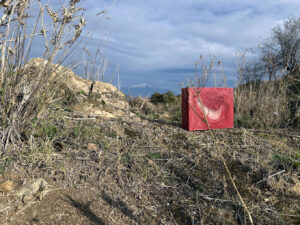
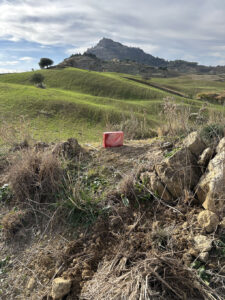
You often see towns in Sicily that are placed on mountains or hills. Here too, the small town of Agora itself takes the form of a volcanic mountain. It has great advantages, especially because of the very hot climate in summer and the earthquakes that can always occur. A few hundred metres higher than the surrounding countryside, it is automatically a few degrees cooler; the wind blows through the alleyways, through which no swanky limousines or SUVs can fit.
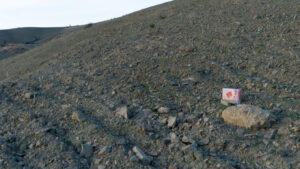
2D1C, “DURO” was placed in Randazzo, Sicilia.
I hope you enjoyed our green-red road between the North and the deep South and centre of the Mediterranean, Sicily.
Geologically speaking, Sicily is already Africa. In this respect, these placements can also be seen as a prelude to our workshops and placements in Senegal, which are taking place during the Dakar Biennale.
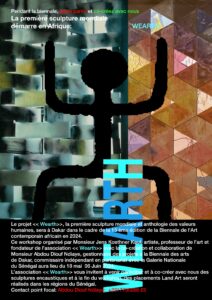
I wish us and you that this works out, and all the best for the New Year.
